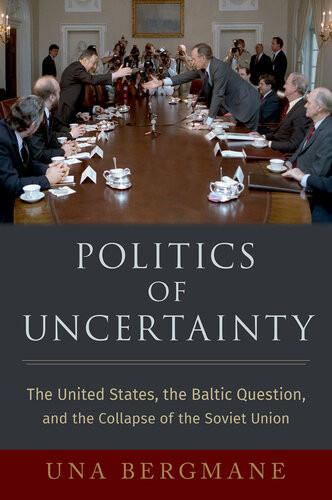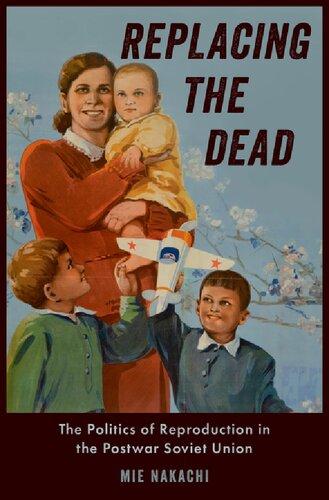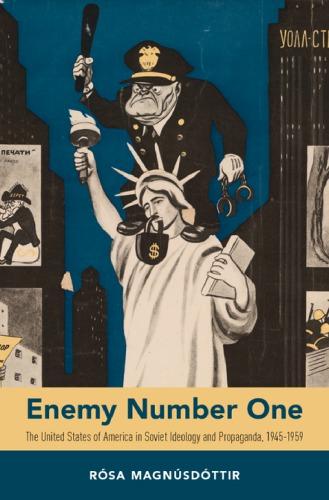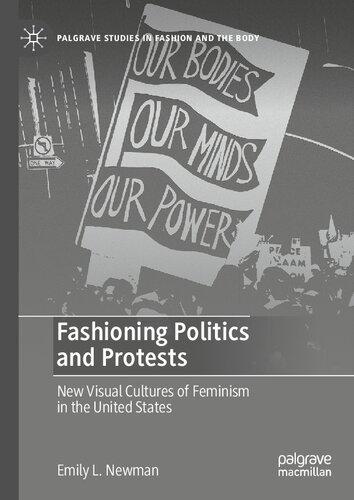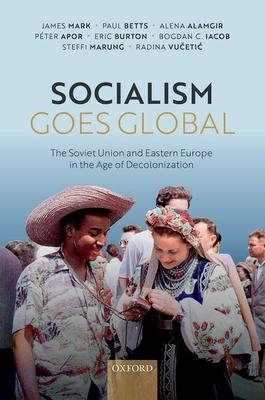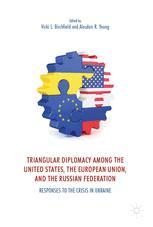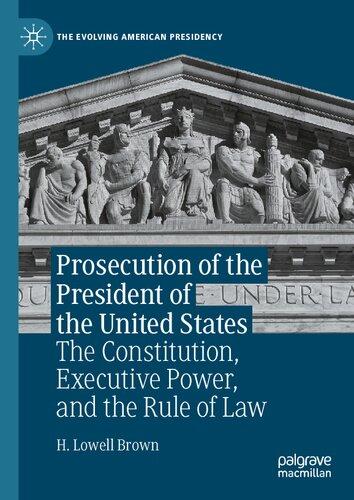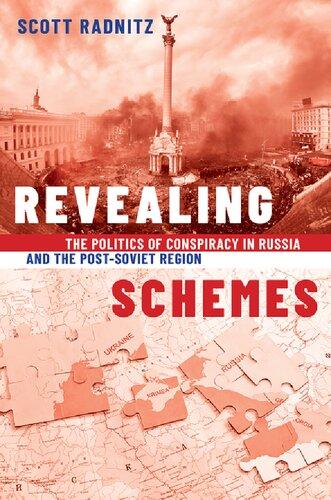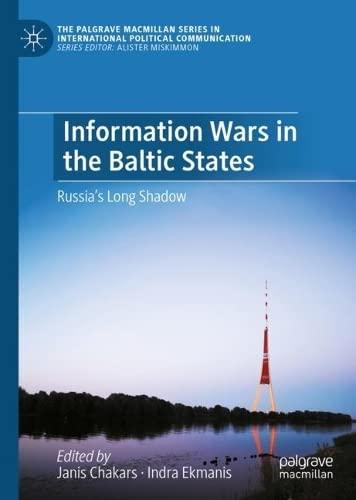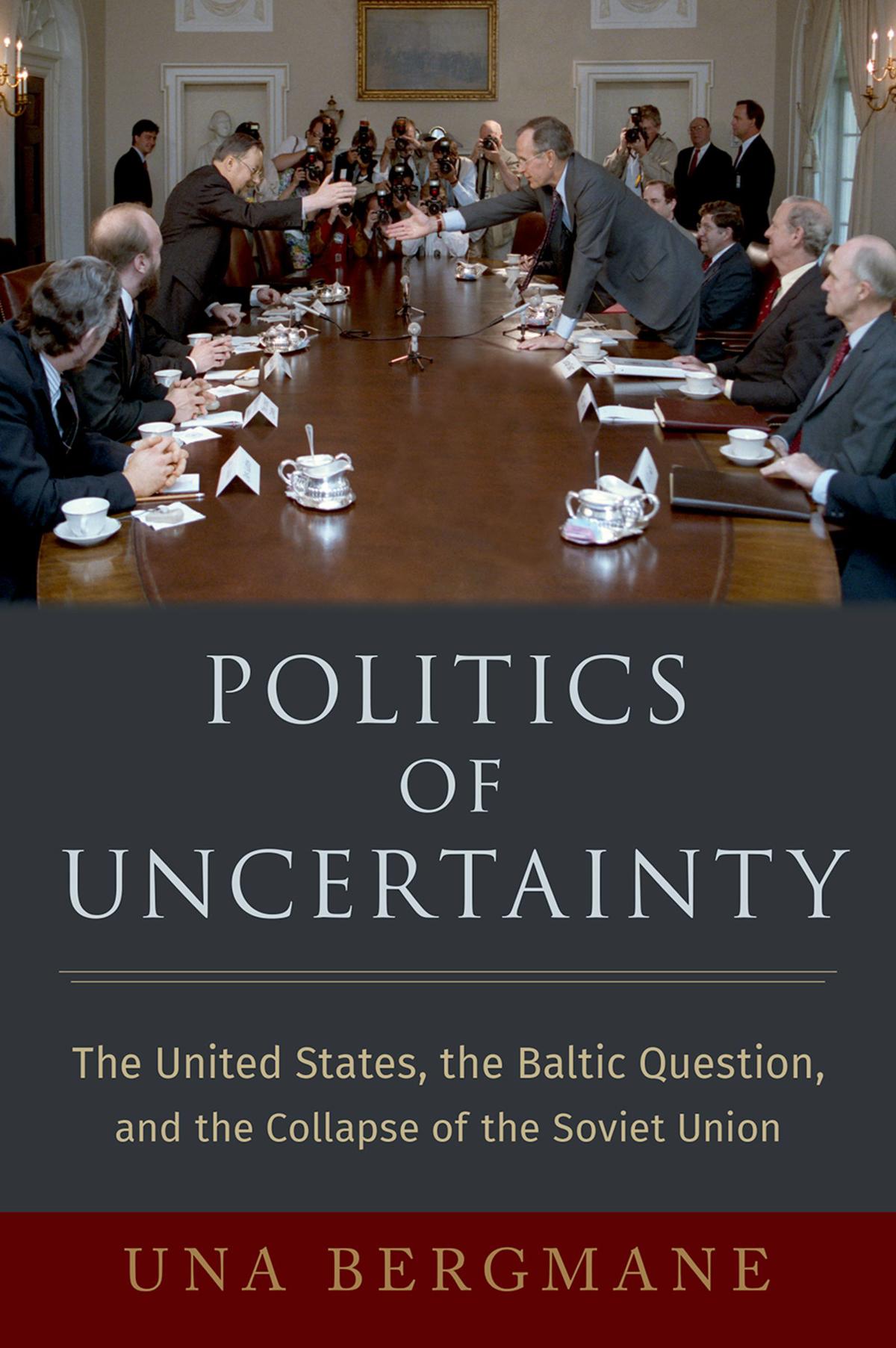OLITICS OF UNCERTAINTY
The UnitedStates, the BalticQuestion, andthe Collapse ofthe SovietUnion
Una Bergmane
Oxford University Press is a department of the University of Oxford. It furthers the University’s objective of excellence in research, scholarship, and education by publishing worldwide. Oxford is a registered trade mark of Oxford University Press in the UK and certain other countries.
Published in the United States of America by Oxford University Press 198 Madison Avenue, New York, NY 10016, United States of America.
© Oxford University Press 2023
All rights reserved. No part of this publication may be reproduced, stored in a retrieval system, or transmitted, in any form or by any means, without the prior permission in writing of Oxford University Press, or as expressly permitted by law, by license, or under terms agreed with the appropriate reproduction rights organization. Inquiries concerning reproduction outside the scope of the above should be sent to the Rights Department, Oxford University Press, at the address above.
Portions of Chapter 4 are adapted from Una Bergmane, “‘Is This the End of Perestroika?’ International Reactions to the Soviet Use of Force in the Baltic Republics in January 1991,” JournalofColdWarStudies(2020) 22 (2): 26–57. Used with permission of MIT Press. You must not circulate this work in any other form and you must impose this same condition on any acquirer.
Library of Congress Cataloging-in-Publication Data
Names: Bergmane, Una, author.
Title: Politics of uncertainty : the United States, the Baltic question, and the collapse of the Soviet Union / Una Bergmane.
Description: New York, NY : Oxford University Press, [2023] | Series: Oxford studies in international history | Includes bibliographical references and index.
Identifiers: LCCN 2022053641 (print) | LCCN 2022053642 (ebook) | ISBN 9780197578346 (hardback) | ISBN 9780197578360 (epub) | ISBN 9780197578377 (oso)
Subjects: LCSH: Baltic States—Foreign relations. | United States— Foreign relations—Baltic States. | Baltic States—Foreign relations— United States. | Soviet Union—Foreign relations—United States. | United States—Foreign relations—Soviet Union. | Baltic States—History—1940–1991.
Classification: LCC DK502.715 .B47 2023 (print) | LCC DK502.715 (ebook) | DDC 947.9084—dc23/eng/20221109
LC record available at https://lccn.loc.gov/2022053641
LC ebook record available at https://lccn.loc.gov/2022053642
DOI: 10.1093/oso/9780197578346.001.0001
To Ukrainian scholars and students who became soldiers, who became refugees, who continued to work and study despite the war that Russia waged against their country.
CONTENTS
Acknowledgments
Introduction
1. The Origins of the Baltic Question
2. “Have you not noticed our absence?”: The Baltic Question during the Annus Mirabilis of 1989
3. Building a New World Order?: The Lithuanian Crisis of Spring 1990
4. The End of Perestroika?: The Baltic Quest for Visibility and the Soviet Crackdown
5. The Rise of the Republics, the Fall of the Center: The Baltic Exception and the Collapse of the USSR
Conclusion
Notes
Bibliography
Index
ACKNOWLEDGMENTS
First and foremost, I want to thank Mario del Pero for his long-term mentorship, his interest in my work, and his support for my academic career.
This book originates from a doctoral dissertation that I wrote at Sciences Po under the supervision of Maurice Vaïsse and Anne de Tinguy. I’m thankful to both of them for agreeing to supervise my thesis and for their feedback on my work. I’m also grateful to the Fondation nationale des sciences politiques for funding the first three years of my doctoral studies.
Over the past ten years I benefited from the support of the Association for the Advancement of Baltic Studies. Aina Birnitis Dissertation-Completion Fellowship, Mudīte I. Zīlīte Saltups Fellowship, and AABS Emerging Scholars Grant have allowed me to conduct crucial research in the American archives and finish my dissertation. In 2020, Oxford University Press received the AABS Book Publication Subvention for the publication of this book. Beyond financial assistance, AABS has also provided a framework for exchanges with the vibrant community of Baltic Studies scholars worldwide. I’m especially grateful to Andres Kasekamp for being part of my thesis committee and for his ongoing interest in my work.
One of the highlights of my doctoral studies was the year I spent at Yale University as a Fox International Fellow. I’m very thankful to late Joseph Carrère Fox, whose commitment to international knowledge exchange made this experience possible. Julia Adams, who served as director of the Fox International Fellowship, continued to support my academic endeavors long after I left New Haven. I appreciate her kindness more than I have had a chance to express.
After defending my PhD, I left Paris and spent a wonderful year as a postdoc at the Mario Einaudi Center at Cornell University. My
biggest thanks go to Matthew Evangelista not only for his comments on my work but also for his unwavering support for my career.
Large parts of this book were written during my two-year teaching fellowship at LSE. I would like to thank Matthew Jones and Piers Ludlow for creating a work setting that was truly enjoyable and productive. Kristina Spohr was on a sabbatical year during my time at LSE, but as I was teaching her courses, those two years felt like a long intellectual exchange with her. As one of the very few scholars who has worked on the Baltic question at the end of the Cold War before me and has served as a member of my thesis committee, she has a special place in my academic trajectory. I also had a chance to teach the Soviet history course of Vladislav Zubok and to discuss our perspectives on Soviet history during long lunch and coffee breaks and I’m thankful for these exchanges. A special thanks go to my fellow LSE teaching fellows Pete Millwood, Tom Ellis, and Anna Cant, as their support and friendship were crucial in fighting the workload and as well as the angst of the first London lockdown. Pete and Tom, Anita Prazmowska, Dina Gusejnova, Molly Avery, Marral Shamshiri-Fard, and Tom Wilkinson kindly read one of the last drafts of this book and/or my book proposal, and I am forever grateful for their insightful comments. A heartfelt thanks go to Alexandra Medzibrodszky not only for being a fantastic teaching assistant but also for becoming such a good friend.
This book would have been impossible to write without the support and feedback of my Estonian, Latvian, and Lithuanian colleagues Daina Bleiere, Violeta Davoliūtė, Mārtiņš Kaprāns, Mart Kuldkepp, Gustavs Strenga, and Kaspars Zellis. As I finish this book, my thoughts are with Vilius Ivanauskas, the young, brilliant Lithuanian historian who tragically passed away in 2018. During the early years of this project in Paris I greatly benefited from the support of Philippe Perchoc, Céline Bayou, Eric Le Bourhis, Sabine Dullin, Katerina Kesa, Emilija Pundziūtė-Gallois, and Eglė Rindzevičiūtė. Special thanks go to Kaarel Piirimäe, my Estonian comrade in so many academic adventures. I am very thankful to Diana T. Kudaibergenova, Botakoz Kassymbekova, and Anna Whittington for our exchanges on Central Asian and Soviet history.
I have to thank my current academic home Helsinki University, the Academy of Finland, Juhana Aunesluoma, and all my colleagues at the Political History Department and Aleksanteri Institute, for the opportunity to continue building my academic career in an intellectually stimulating, productive, and welcoming work environment.
The long road between the dissertation and the book was traveled in the company of my friends. My time at Sciences Po wouldn’t have been the same without the inhabitants of the salle des doctorants 224 boulevard Saint-Germain, especially Sibylle Duhautois, Anna Konieczna, Charles Lenoir, and Paul Lenormand. I thank them for our many coffee breaks and their years-long support. The oftendaunting task of navigating doctoral and postdoctoral academic life has been made easier by the comradeship of Gaetano Di Tommaso, Michele Di Donato, Andreas Mørkved Hellenes, and Bruno Settis. Marine Guillaume, Silvia Sorescu, and Camilo Umana Dajud, whom I met during my MA studies at Sciences Po, were the ones who made Paris feel like home, and they were the ones who make me long for it. In 2011 I met Cecilia Asperti, Katharina Gnath, and Charu Singh during our Fox Fellowship at Yale. Since then, we have kept being by each other’s side despite often living on opposite sides of the world. The writing of this book has regularly been interrupted, made bearable, and relativized in its importance by the sound of an incoming group chat message. The never-ending conversation that started in the corridors of the Riga French Lycée has become the background rhythm of my life, and I thank Ilze Dalbiņa, Zanda Gajevska, Marta Elīna Martinsone, Anastasija Mežecka, Daina Pravorne, Elīza Simsone, and Sigita Zosule for that and so much more.
I’m deeply grateful to my editor at the Oxford University Press, Susan Ferber, for believing in this project, for her advice and guidance, and for the careful edits of this book. I thank the two anonymous reviewers for their constructive and stimulating feedback.
Last but not least, I have to thank my family. My parents-in-law Sandra and Simi, my belles-soeursMarie and Nora, my goddaughter
Paula, and my godmother Ināra for all the kindness, joy and encouragements they bring to my life. To my best friend Zuzanna, for what I can describe only by paraphrasing what Montaigne said about his friendship with Etienne de La Boétie: “because it is her, because it is me.” To my siblings Marta and Toms, for being my friends and my teachers, my partners in crime, and my soulmates. To my mother Ieva for raising three kids through the tumultuous years of Soviet collapse and post-independence transition, for always beliving in me and for always being my true North. To my husband Lucas for being my love and my rock. For his immense support and help. For the life we have built together. And finally, to those who have left us—my beloved grandparents Arnis and Jana—for having been with us.
Politics of Uncertainty
Introduction
“We are unknown men from an unknown country.”
Kaarel Robert Pusta, head of the Estonian delegation to the Paris Peace Conference, 1919
“After all, if we make a mistake, we will destroy the state.”
—Nikolai Ryzhkov, Soviet prime minister during a Politburo meeting, July 14, 1989
“Who’s the enemy? I keep getting asked . . . it’s the inability to predict accurately; it’s a dramatic change that can’t be foreseen, and its events that can’t be predicted.”
—George Bush, diary entry on February 24, 1990
“You have chosen the Baltics over me and let’s leave it at that,” an angry Mikhail Gorbachev said to George Bush on June 1, 1990.1
Three months earlier, on March 11, Lithuania had become the first Soviet republic to declare its independence. On March 30 and May 4, the two other Baltic states, Estonia and Latvia, announced the beginning of a transition period toward full sovereignty. The USSR, which considered the Baltic declarations illegal, harshly condemned them and imposed an economic blockade against Lithuania. Fearing an outbreak of violence in the region, the United States tried to deescalate the crisis, pressuring all sides to engage in dialogue. When the Soviet and American presidents met during the Washington summit in June, Gorbachev, to his great surprise, realized that Bush was seriously considering not signing the newly negotiated Soviet American trade treaty because of the Baltic situation. The idea that the United States could refuse to support the Perestroika effort because of events in the Soviet periphery outraged Gorbachev. To
him, Estonia, Latvia, and Lithuania were an integral part of the USSR, and their secessionist tendencies were a distraction from what actually mattered—the monumental opportunity for change that the Perestroika project offered to his country and the world.
The Soviet president was not the only one whose hierarchies of importance were challenged by the sudden re-emergence of the Baltic question on the international agenda. George Bush, France’s François Mitterrand, and Germany’s Helmut Kohl were equally exasperated by the events at the margins of the Soviet empire that risked destabilizing Gorbachev and souring East-West relations at the time of German Reunification. Yet, for various reasons, the big powers were unable to keep the Baltic question out of international politics.
First and foremost, most Western states had not recognized the 1940 Soviet annexation of the Baltic countries as legal, and thus from 1989 to 1991, the White House had to perform a highly challenging balancing act: affirming their full support for the reformer Mikhail Gorbachev while claiming that in principle the three Baltic states deserved their independence. Furthermore, the Baltic question was not just an American foreign policy issue; domestic and transnational actors such as the US Congress and Lithuanian, Latvian, and Estonian diasporas actively pushed for a stronger US stand on Baltic independence. Finally, there was general uncertainty about how to deal with the disintegration of the Soviet Union. The rapidly changing situation in the USSR prevented the US government from having a coherent policy toward Soviet collapse, making it the object of endless hesitations and improvisations. Between 1989 and 1991, Washington and its European allies moved from extreme prudence regarding the Baltic claims to unconditional support for their independence. However, this change was reluctant and driven much more by domestic pressures and last-minute decisions than by realpolitik calculations and long-term strategy.
Moscow’s problem with the Baltic countries can be best described in the words of Anatolijs Gorbunovs, a high-ranking Latvian communist who came to fully embrace the independence project between 1988 and 1990: “Gorbachev had no plan: neither how to let
us free, nor how to keep us.”2 The Soviet leader indeed had no plan of how to deal with center-republic relations in general and the Baltic situation in particular. At first, around 1987, it seemed that there was no need to worry about Estonia, Latvia, and Lithuania; the three republics were relatively rich and relatively calm, there were no outbreaks of ethnic violence, and their leadership supported Perestroika. Then suddenly, starting from 1990, it was too late. Tallinn, Riga, and Vilnius pushed for independence and engaged in an active foreign policy. Baltic officials traveled to the West and were received at the White House, Élysée Palace, and Downing Street. In reality, of course, the pro-independence shift in the Baltic countries was not at all instantaneous. It had both historical and structural causes, but the Soviet power caught in the tremendous effort of implementing Perestroika reforms had no time, no plan, and no expertise to address grievances in the periphery. Since the early days of the Soviet state, relations between the Soviet center and the republics had been imperial: they were rooted in a system of interaction in which the dominant metropole exerted political control over the internal and external policy—the effective sovereignty—of the subordinate periphery.3 When, after 1985, both the democratizing rationale of Perestroika and actors in the periphery pushed for reform in center-republic relations that would reduce the power asymmetry at the heart of the Soviet federal system, Moscow was caught unready, hesitant, and overwhelmed by other seemingly more urgent issues.
First and foremost, this book tells the story of how Moscow and Washington tried to deal with independence movements at the Soviet periphery, namely the Baltic countries. This problem at first seemed minor, but as it started to gain more and more international visibility, it risked derailing “the real issues” that actually mattered in the eyes of both Soviet and American leaders—the transformation of the Soviet state and transformation of international order. Second, it is an account of how, at times of profound historical change, marginal actors defy their marginality and find strategies for gaining visibility on the international stage.
In other words, this is a book about superpower struggles with uncertainty and Baltic struggles with invisibility. Through them, it tells a broader story of the Soviet collapse.
As an analytical concept, uncertainty carries multiple implications in international relations. It has been conceptualized either as fear or ignorance due to the lack of information or as confusion and indeterminacy arising from the ambiguity of information.4 For the Bush administration, the problem was not a lack of information about the situation in the USSR but rather its abundance and ambiguity. The unexpected rise of a reformist leader in the USSR left Americans in uncharted waters, and they struggled to ascribe meaning to Gorbachev’s actions and untangle the complexity of the Soviet internal struggles. In 1989 the incoming Bush administration mistrusted the Soviet leader and blamed President Reagan for not seeing the iron fist hidden in the velvet glove.5 The US initiated pause in Soviet-American relations that lasted from Bush’s inauguration day until the autumn of 1989 was directly due to American uncertainty about Soviet intentions. Two key questions preoccupied the American decision makers: was Gorbachev a genuine reformer, and would he be able to survive politically? Both had direct implications for US Baltic policy.
While after the fall of the Berlin Wall it seemed clear that the Soviet Union would not resort to violence to stop the democratization of Eastern Europe, the White House continued to fear a military crackdown in the Baltic republics. Constant American requests not to use force in Estonia, Latvia, or Lithuania were among the few consistent elements in US dealings with the Baltic question. At the same time, American leadership worried that the Baltic drive for independence could destabilize Gorbachev and thus tried different and often contradictory approaches to ease the tensions between Moscow and the Baltic capitals. Yet, Gorbachev’s survival was not an end in itself. While cautioning the Estonians, Latvians, and Lithuanians not to put too much pressure on Gorbachev with their claims for independence, the White House did not hesitate to
pressure him towards accepting full NATO membership for reunited Germany.6
Gorbachev’s ambitious reforms pushed the Soviet society into an unknown territory, making uncertainty the everyday experience of all Soviet citizens. The Soviet leader and his advisors had a vision of a new, reformed Soviet Union, but they did not have a clear plan for how to handle the economic and social forces that were unleashed by the reforms. The routines and practices of center-periphery relations in the USSR were established for an authoritarian framework and shaped according to the imperial paradigm in which Moscow had the final say over the republics’ affairs. However, the democratizing effect of Perestroika completely changed these dynamics. Starting from 1988, central power had to face something it had not seen before: an increasingly pluralistic and democratic periphery. On the one hand, Gorbachev and his entourage struggled to adapt to the new situation, in which it was not clear whom they could trust and to whom they should talk in the rapidly changing Baltic political landscape. On the other hand, Gorbachev’s willingness to dwell upon this problem was limited, as his agenda was already oversaturated with seemingly more urgent issues including failing economic reforms, Armenian–Azerbaijani conflict over the NagornoKarabakh region, and international arms negotiations. Gorbachev’s liberal advisors were proposing considerable autonomy or even independence for the Baltic republics. At the same time, the conservative forces gradually grew into the idea that force was the only answer to the Estonian, Latvian, and Lithuanian drive for independence. Caught between the two, Gorbachev hesitated and procrastinated, while the three Baltic republics progressed from demands of larger autonomy toward a determined push for independence.
The dynamics surrounding the Baltic question can be better understood by taking a broader perspective on Perestroika and what it meant for both Soviet society and the international community. This book relies on scholarship that conceptualizes Perestroika not just as a project of political and economic reforms but also as an
attempt to both forge domestically and project internationally a new Soviet identity.7 The scope and depth of reforms in both domestic and foreign policy envisioned by the Soviet liberal thinkers required no less than a reconceptualization of key ideas about the nature of the Soviet state and its place in the world. In domestic policies, it meant gradual embrace of such international norms as human rights, free speech, and democracy.8 As Eduard Shevardnadze put it: “If we want to be a civilized country, we must have the same laws and regulations as the rest of the civilized world.”9 In foreign policy, it demanded the abandonment of what Alexander Yakovlev, one of the key Perestroika thinkers, called the “psychology of the besieged fortress.”10 The encircled revolutionary state was to become a member of a larger Western (and/or European) community, sharing values more important than class interests.11 A key element in this Soviet paradigm shift was the refusal to use force both internationally and domestically. Although excessive state violence had been one of the pillars of the Soviet system since its inception, Gorbachev initially refused to see it as an option for solving international disputes and internal problems. At the same time the changes that Perestroika brought were never supposed to entail a dismantelemnt of the Soviet empire. While Gorbachev and his allies were willing to recosinder some of the imperial practices and reduce the power assimietry between the center and the republics, they planed to reform not to destroy the Soviet Union. Thus the story of Gorbachev’s relations with Lithuania, Latvia, and Estonia is not just a story about the relations between the Soviet centre and the periphery at the time of Perestroika, it is also a story of a deep tension at the heart of the Perestroika project: the incompatibility between the democratisation of Soviet society and the preservation of the Soviet empire.12
The United States and its allies were pleased about and responsive to these developments but constantly wary that the window of opportunity opened by Gorbachev’s reforms might close. The West’s fears of a military coup, civil war, or general collapse of the USSR that could disturb the favorable international situation
have often been mentioned in memoirs and scholarly literature.13 Much less has been written about the fears of Westerners and Soviet liberal forces that Gorbachev himself could halt the reforms and sour East-West relations by starting a crackdown in the Baltics. This book demonstrates how, in the eyes of many, the state of the relations between the rebellious republics and Gorbachev was closely linked to the state of Perestroika. When Gorbachev drifted toward the conservatives and force was used in Vilnius and Riga, Soviet supporters of Perestroika, as well as Western policymakers, became alarmed about the future of Soviet reforms.
These dynamics show the role that norms and normative expectations played during the Perestroika years, both internationally and domestically. Norms, as collective expectations for the proper behavior of actors of a given identity, play both constitutive and regulative roles.14 In the first case, they define actors’ identities, while in the second, they function as standards prescribing behavior. Both Soviet liberal democratic circles and the international community expected the leadership of the newly reformed Soviet Union to find a peaceful solution to the Baltic problem. For the Soviet liberals, rejection of violence as a tool for achieving political goals was part of the larger enterprise of defining a new Soviet identity. Meanwhile, for the West, the Soviet refusal to use force in Eastern Europe was one of the main elements in overcoming the Cold War alienation and recognizing sameness in the former Soviet “other.” In other words, while in Soviet internal politics abstention from excessive state violence played a constitutive role, on the international stage it had a regulative function: Soviet compliance with this norm reinforced the image of the new Soviet identity, shaped by the values of liberal democracies.15
The struggle for social visibility as a quest for empowerment is a key element in social movements’ strategies and small-state foreign policy. Marginalized groups seek recognition from the mainstream to secure their rights: in a Hegelian perspective, freedom requires recognition by the other for its self-realization.16 In this sense,
internal politics are continuously shaped by recognition struggles. While Hegel himself was reluctant to apply his concept of recognition to interstate relations, international relations scholars have claimed that states seek not only recognition in the legal sense but also an international affirmation of their internally forged identity.17
The Estonian, Latvian, and Lithuanian independence movements first acted as non-state actors challenging Soviet power. After winning the 1990 elections and proclaiming independence or transition toward independence, they became representatives of three small states with complicated international status. At both stages, they reached out for international support but struggled to be seen and heard. To a certain extent, this was a practical problem that all small states encounter; while larger powers focus on changing the perception that others have of them, small states must first make a considerable effort to be seen.18 For Estonia, Latvia, and Lithuania, the task was even more complicated. Until August 1991, their independence was not recognized and therefore they were not supposed to have a voice in the Westphalian system of sovereign states. Furthermore, in the eyes of Western policymakers the Baltic question was not perceived as important enough to actually be included in international negotiations at the time of German unification and the first Gulf War.
However, visibility in the international arena was essential for Baltic activists. Since their first calls for independence in 1989, Baltic pro-independence elites had been very skeptical of a scenario in which the USSR would willingly grant independence to Estonia, Latvia, and Lithuania. According to the official rhetoric of the independence movements, Baltic statehood should not depend on the USSR because Soviet power in the Baltic region was illegal. In reality, Baltic leaders simply did not believe that Moscow would ever be willing to let their countries leave the Union. Thus, independence seemed to be achievable only through international negotiations and international recognition. The idea of achieving national independence through the internationalization of the issue was not a new one. For example, the most decisive struggles for the
independence of Algeria were carried out in the international arena.19 Indeed, the situations were similar to the extent that neither Algerian nor Baltic nationalists were able to control their national territory, and thus their claims for sovereignty were abstract and largely dependent on their capacity to delegitimize French or Soviet rule internationally.
At the same time, international visibility had deeper meaning for the Baltic countries, beyond practical considerations. The rise of the Baltic independence movements was, to a considerable extent, an unintentional result of Perestroika. They started off in 1988 as popular fronts created to support Gorbachev’s reforms: the three most prosperous Soviet republics20 were especially eager to reform the Soviet system. Glasnost gave unprecedented freedom of speech to Soviet citizens and revealed deep frustration with Soviet rule in Estonia, Latvia, and Lithuania. Environmental concerns, anxiety over the low birth rates, discontent with the influx of migrants from other Soviet republics, and frustrations generated by long-term contradictions in Soviet nationality policies were amplified by the revelations of the scope of Stalin’s repressions in the Baltic republics. These developments increased ontological insecurity—a collective, socially constructed, and subjective fear about the future of the collective selves, defined as Estonian, Latvian, and Lithuanian nations.21 By consequence in the late 1980s and early 1990s Baltic activists and governments saw themselves as being engaged in “existential politics” struggling for independence as a precondition of national survival.22
In turn, the emerging ontological insecurity accelerated the push toward independence, perceived in large parts of Baltic societies as the only sustainable future for the Estonian, Latvian, and Lithuanian nations. In the context of these existential anxieties, the international community functioned as the significant other that tests and testifies one’s existence.23 What Baltic independence activists sought was not only legal but also existential recognition and affirmation. Political scientist Erik Ringmar has distinguished four types of recognition that individual and collective actors seek: (1)
visibility; (2) equal treatment; (3) acknowledgment of actors’ individuality; and (4) acceptance by a group in which actors believe they belong.24 For Estonian, Latvian, and Lithuanian independence activists, all these steps mattered: they wanted to be perceived as European nations, they underlined their specificity in the Soviet context, and they argued that their independence claims were as legitimate as were German calls for unity. This book traces the strategies that Baltic American diaspora, Baltic independence movements, and Baltic governments used for achieving visibility and recognition in both legal and ontological senses.
Much research has been published on the international and internal causes of the Soviet collapse, but very few works have made the connection between the two.
Among the many internal factors that have been viewed as contributing to the fall of the USSR are: the failure of the Soviet ideological project, misguided reforms, economic decline, interethnic tensions, the ethno-federal structure of the Soviet state, malfunctioning of its institutions, and the bid for power by republic elites.25
Works that deal with external influences upon the Soviet collapse have mostly focused on the interactions between Moscow as the imperial center and the outside world, especially the United States. Scholars have debated the role that Reagan’s foreign policy did or did not play in the destabilization of the USSR and analyzed Bush’s attempts to change the international order without destabilizing the USSR.26 Meanwhile, other scholars have discussed long-term transformations in the Soviet elite’s perception of the West and Europe, Western ideas, and universal values.27 These works largely focus upon decision makers and elites in Moscow, projecting the impression that during the Soviet collapse, the central government still functioned as a gatekeeper between the international community and other Soviet actors. However, notable exceptions include scholarship on the impact that the collapse of Eastern European communism had upon Soviet republics,28 the role of
Ukraine in the Soviet collapse and the US attitude toward Ukrainian independence,29 and Western (especially West German) attitudes toward Baltic claims for independence.30 PoliticsofUncertainty aims at contributing to this emerging scholarship by studying the triangular relations among Moscow, the Baltic capitals, and Washington and highlighting the interconnections between the domestic and external factors in the Soviet collapse.
It has often been argued that, despite their geographical proximity, Estonia, Lithuania, and Latvia are too different to be put under the same “Baltic” label. Indeed, their grouping as the Baltic states is a rather recent phenomenon. In the eighteenth and nineteenth centuries, the world Balt was used to refer to the Baltic Germans, who at the time constituted the ruling class in most parts of the current-day Estonia and Latvia.31 As a result, the Baltic provinces of the Tsarist Empire were Estonia (northern parts of contemporary Estonia), Livonia (Southern Estonia and Northern Latvia), and Kurland (Western Latvia). In the interwar period, the term “Baltic states” appeared for the first time, but it included not three but four countries, linking Finland to its southern neighbors. It was only in the context of the Cold War that the international community started to use the term “Baltic states” to designate Estonia, Latvia, and Lithuania. At the same time, Soviet citizens referred to the three as “Baltic Republics.”
The three Baltic nations, often perceived as almost identical, are very different indeed. The Latvian and Lithuanian languages are the last living ones of the Baltic language group, which belongs to the Indo-European family. Estonian is a Finno-Ugric language. Estonians are Protestants, Lithuanians are Catholics, and Latvians are predominantly Protestants, with a Catholic region in the southeast of the country. Furthermore, both Estonia and Latvia have a significant Russian-speaking minority that is mostly Orthodox.
Latvians and Estonians share a similar history, from which Lithuania diverges. The Estonian and Latvian ancestors were Christianized during the thirteenth century by Northern German
missionaries with the military support of the Teutonic Order. Lithuanian pagans resisted the Crusaders, and the Duchy of Lithuania was founded in mid-thirteenth century. In 1387 it became the last European country to formally embraced Christianity. In 1569, the Grand Duchy of Lithuania and Poland formed the PolishLithuanian Commonwealth. Until 1561 the territory of present-day Latvia and Estonia was part of medieval Livonia, a set of territories governed by local bishops and the Teutonic Order. From 1561 to the early eighteenth century, the former Livonia was divided between Polish-Lithuanian Commonwealth and Kingdom of Sweden. In 1721, the region of present-day Estonia and a large part of Latvia were conquered by Peter the Great. Lithuania and Southern Latvia were included in the Russian Empire after the partition of the Commonwealth by Russia, Habsburg monarchy, and Prussia in the late eighteenth century. In general, the history of Estonia and Latvia was very much influenced by the presence of “Baltic barons”, or Baltic Germans who arrived in the region during the Crusades and formed the aristocratic elite of both Latvia and Estonia until the First World War. The history of the Lithuanian people is marked by their relations with Poland. Even after the proclamation of independence in 1918, Lithuania’s internal dynamics and its international position were strongly influenced by its conflict with Poland over the city of Vilnius. An authoritarian coup d’état took place in the same year as the one in Poland (1926), while Latvian and Estonian democracies survived from 1918 until 1934.
Despite these differences, all three Baltic countries were occupied by the USSR in 1940, and 43,000 of their inhabitants were deported to Siberia on June 14, 1941.32 In late June 1941, all of them were occupied by Nazi Germany, and 90 percent of their Jewish citizens were killed by the occupying power and local collaborators. In all three countries, the populations both resisted and collaborated with the USSR and Nazi Germany, but the situation was more complicated in Latvia and Estonia, where Nazi Germany created special Latvian and Estonian Legions in the Waffen SS. Thus, by the end of the war, Latvians and Estonians were fighting in the ranks of the Red Army as
well as on the Nazi side. Between 1944 and 1945, about 140,000 Latvians, 75,000 Lithuanians, and 65,000 Estonians left their homelands as war refugees.33 After the Second World War in all three countries, the so-called forest brothers continued to lead a partisan war against the Soviet Union. In Lithuania, this resistance movement was much stronger than in Latvia and Estonia. On March 25, 1949, 95,000 additional residents of Estonia, Latvia, and Lithuania were deported to Siberia. The most important difference between the three countries during the Soviet period was, that while the ethnic situation did not change much in Lithuania, it was drastically modified in Estonia and Latvia by the arrival of migrants from other Soviet republics, mostly from Russia, Ukraine, and Belarus.34
Thus, while the Baltic states’ languages, historical experiences, and religious affiliations differ, this book analyzes them collectively for two reasons. First, between 1989 and 1991, the international community, as well as the Soviets, were dealing with the “Baltic question” and did not separate the Lithuanian, Latvian, and Estonian issues. Annexed by the USSR in 1940, the three countries were the only Soviet republics that, in Western perception, legally did not belong to the USSR. They were the only ones with twenty year experience of independent statehood in living memory and the first ones to challenge the integrity of the Soviet Union. Second, in light of their common tragic history and the similar challenges they faced in their quest for independence, all three populations showed a considerable degree of solidarity while their leaders sought to cooperate. In other words, the external actions of Estonians, Latvians, and Lithuanians during these three consequential years can be analyzed together because their situations vis-à-vis the USSR were similar. Likewise, they were similarly perceived by the West, and their leaders opted for coordination and cooperation.
To create a fuller picture of the triangular relations among the Baltic states, the USSR, and the United States, this books relies on research conducted in multiple archives throughout Europe as well
as primary sources from the United States and in the Russian Federation.
To convey the Baltic side of the story, it draws on the Estonian national archives, Latvian national and diplomatic archives, and Lithuanian diplomatic archives. To tell the American side of this story, it utilizes, among others, papers from the Bush administration and its key players, congressional records, and the National Security Archive.
The research on the Soviet side of the story has been facilitated by materials from the Gorbachev Foundation, excerpts from Politburo meetings, and documents on Soviet attempts to handle center-republic relations.35 While these sources provide essential insights into Soviet policies and debates, the selected documents are often only partially published and thus sometimes yield more questions than answers. Beyond these archival sources, the book draws on twenty-seven original interviews carried out with American, Estonian, French, Latvian, and Lithuanian diplomats and officials, as well as with Baltic diaspora activists.
The book traces the raise and resolution of the Baltic questions over a time span of about fifty years. The first chapter covers the period from the occupation of the Baltic states in 1940 until the Perestroika era. Meanwhile, the four other chapters analyze the crucial years between 1989, when the Baltic poplar movements first proclaimed independence as their ultimate goal, and 1991, when three months after the recognition of Estonian, Latvian, and Lithuanian independence, the Soviet Union collapsed.
Chapter 1, “The Origins of the Baltic Question,” provides an overview of the three elements that made the Baltic situation a specific case in the Soviet context: the decision in 1940 by the United States not to recognize the annexation of Estonia, Latvia, and Lithuania as legal, the emergence of an active and well-organized Baltic-American diaspora during the Cold War, and the rise of the Baltic independence movements in the late 1980s. In addressing these three topics, the complexity of the Baltic issue is revealed: the legal debate about their international status, the ties between the
Baltic diaspora and the US Congress, and the multi-causal roots of Baltic discontent with the Soviet rule.
Chapter 2, “ ‘Have you not noticed our absence?’: The Baltic Question during the Annus Mirabilis of 1989,” follows the transformation of the Baltic question from a purely internal Soviet nationalities problem to an international issue in 1989. It analyzes the Soviet and American policies toward Estonia, Latvia, and Lithuania in the context of Eastern European revolutions, highlighting the American unwillingness to get involved with the Baltic question, as well as the country’s inability to avoid it. The chapter sheds light on Baltic attempts to use the history of the Molotov-Ribbentrop Pact to delegitimize Soviet rule, both at home and abroad. It pays particular attention to the relations between Baltic independence movements and other Soviet actors such as Gorbachev’s liberal advisors, Yeltsin’s circle, and other republics. The chapter ends with the Malta summit, during which Bush and Gorbachev failed to effectively communicate their respective positions on the Baltic issue.
Chapter 3, “Building a New World Order?” The Lithuanian Crisis of Spring 1990,” examines American policy regarding the so-called Lithuanian crisis, a period of increasing tensions between the USSR and the Baltic states, which started with the Lithuanian independence declaration on March 11, 1990, and ended with its suspension on June 29, 1990. The international context and the ongoing talks on German reunification were crucial in shaping not only the American but also the European responses to the Baltic declarations: the Baltic situation had to be appeased before it derailed negotiations on German reunification. It argues that the White House’s attempts to defuse the crisis were often hesitant, chaotic, and to a considerable extent driven by congressional pressures and Baltic diaspora grievances.
Chapter 4, “The End of Perestroika?: The Baltic Quest for Visibility and the Soviet Crackdown,” looks at the Baltic efforts to engage with the international community during the second half of 1990, which ended with their expulsion from the CSCE Paris summit. The chapter then analyzes Gorbachev’s so-called turn to the right, the use of
force in the Baltics in January 1991, and the international reactions to these events in the context of the Gulf crisis. It explains the international and Soviet domestic outrage that followed the deaths of twenty civilians in Vilnius and Riga by a general fear that violence in the Baltic countries meant the end of Perestroika. The chapter describes the initial American hesitation to take a strong stand against Gorbachev in the wake of the Gulf War and the subsequent hardening of the White House attitude after the killings in Riga. It argues that international pressures played a crucial role in stopping the Soviet crackdown in the Baltics.
Chapter 5, “The Rise of the Republics, the Fall of the Center: The Baltic Exception and the Collapse of the USSR,” underscores US attempts to understand the complexity of the Soviet domestic struggles and predict the possible future of the USSR during the first half of 1991. It describes the increasing power diffusion in the Soviet Union and the growing cooperation between the Baltic states and Boris Yeltsin before turning toward the international recognition of the Baltic states after the August coup. The US and European decisions to restore diplomatic relations with the Baltic states did not mean the abandonment of Gorbachev or acceptance of Soviet disintegration. Rather, it was a final disconnection of the Baltic and Soviet questions.
Thirty years after the Soviet collapse, this book aims to tackle the interplay between international and domestic dynamics in the Soviet disintegration process. Based on extensive archival research, it investigates the triangular relations among the US government, Baltic independence movements, and Moscow during the Perestroika years. Both Washington and Moscow wanted to defuse the Baltic crisis, but neither was certain about how to do it. The United States tried to perform a highly changeable balancing act of supporting Baltic independence without jeopardizing its relations with the Kremlin. Meanwhile, Gorbachev faced an increasingly pressing choice between democratization and preservation of the Soviet empire. In other words, this book studies the relations between those at the top of international and domestic power hierarchies with those situated at their margins. It shows how at the time of deep historical
change the disruption of existing power structures causes uncertainty that limits the agency of the powerful and opens windows of opportunity for those seen as marginal.
